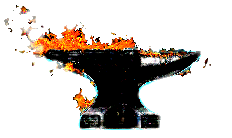Weight clearly marked in
English Hundredweight with the midle numeral centered in the circular "SOLID WROUGHT" logo.
While the other English anvil manufacturers very gradually developed the "London Pattern" shape Peter Wright brought art to the lines of the anvil producing the most familiar and recognizable "anvil shape".
The Peter Wright lines were copied by many others and defined the anvil shape of the late 19th and early 20th century.
Peter Wright advertised that they used nothing but NEW wrought iron while others used the "best scrap".
This resulted in an anvil less likely to break but also more likely to sway.
The scrap of the era would have some steel in it and be more rigid than pure wrought.
To combat the sway Peter Wright crowned their late anvils like a roadway.
Weight: 0 . 3 . 7, 91 pounds (41 kg)
Links:





While the other English anvil manufacturers very gradually developed the "London Pattern" shape Peter Wright brought art to the lines of the anvil producing the most familiar and recognizable "anvil shape". The Peter Wright lines were copied by many others and defined the anvil shape of the late 19th and early 20th century.
Peter Wright advertised that they used nothing but NEW wrought iron while others used the "best scrap". This resulted in an anvil less likely to break but also more likely to sway. The scrap of the era would have some steel in it and be more rigid than pure wrought. To combat the sway Peter Wright crowned their late anvils like a roadway.
Weight: 0 . 3 . 7, 91 pounds (41 kg)
Links: